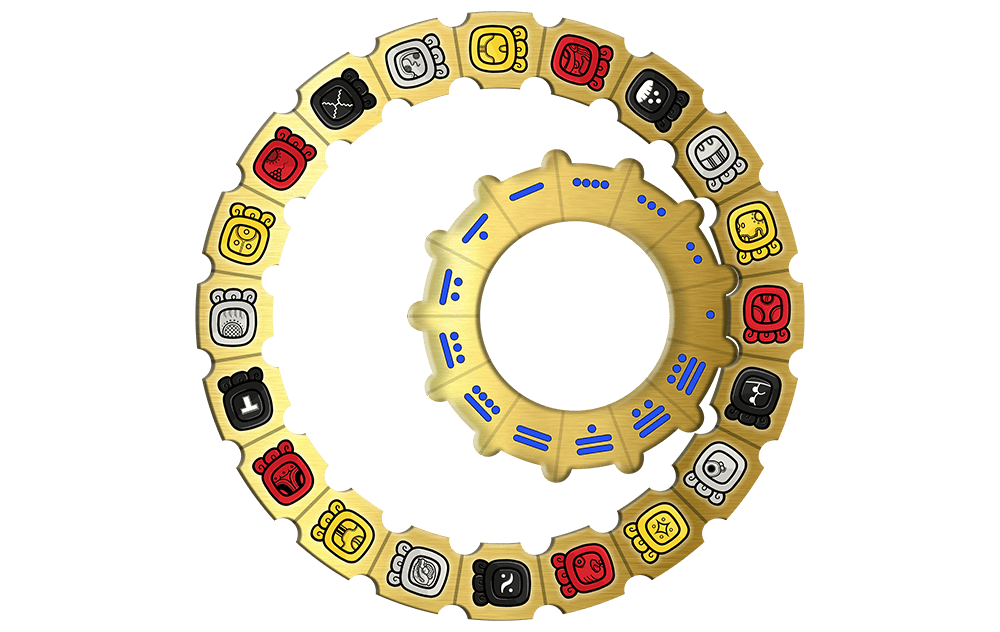CHOLQ'IJ
THE 260-DAY
SACRED
MAYA CALENDAR
The Cholq’ij (Order of Days), also known as Tzolk’in, is the sacred Maya calendar that calculates time as consciousness and understands the relationship between Earth and Sky, the feminine and masculine aspects of nature that give birth to life and originate events.
The Cholq’ij (Order of Days), also known as Tzolk’in, is the sacred Maya calendar that calculates time as consciousness and understands the relationship between Earth and Sky, the feminine and masculine aspects of nature that give birth to life and originate events.

THE FOUNDATION
The calendar is based on the human gestation period and a specific variety of corn that is commonly grown in Guatemala’s Highlands. It’s a combination of human and corn gestation, because the corn crop is due in 260 days and the baby is ready in 260 days.
The women’s cycle, and its understanding, are at the core of the calendar.
When it comes to comprehending a person, their patterns of behaviour, their goals, and their life choices, the Cholq’ij journeys to the world of pregnancy to examine what factors in the mother’s experience created that baby’s consciousness. The human-being is viewed as a composite of energies, substances, or spirits acquired throughout pregnancy. The mother creates universes, and the baby, alive and conscious while gestating, experiences the world beyond memory, language, education, and culture.
TIME AS CONSCIOUSNESS
Each day in the Cholq’ij is called Nawal, which is a word that can be described as: Spirit, Substance, Entity or Force of nature. According to some Maya principles:
- Everything has life
- Everything has a way of thinking
- Everything has feminine and masculine principles that gives birth
- Everything has a form of communication or dialogue
- Everything belongs to a system
- Everything can be fed


UNDERSTAND THE SYSTEM
The Cholq’ij is made up of two recurring cycles. One is a 13-day cycle of number nawals, represented by the DOTS and BARS. The other is a nominal day cycle of 20 nawals, represented by the archetypal glyphs. They function in tandem, like cogwheels, to produce 260 unique day combinations of a number and a name. FOR EXAMPLE:

until the same number and name appear again. The calendar has no beginning or end because of its cyclical nature.
TRECENAS


There are several cycles that are tallied within the 260 days of the Maya Calendar, each one for a different purpose of observation, but the main cycle that is observed and used is the Trecena, a 13-day cycle.
The trecena is a system of 13 Nawals. It’s like a bigger entity with 13 heads working together, which gives a sort of a “theme” for that particular period. They explaining the happenings of events, dreams as well as a detailed function of the human-being. In total there are 20 trecenas.
THE CALENDAR'S USES AND BENEFITS
The Maya Calendar is utilised for everything, from life philosophy to shamanic activities. It is the primary tool used by the Ajq’ij (Spiritual Guides) to work on the community’s well-being. On the surface, the calendar can provide benefits such as:
PERSONAL DEVELOPMENT
• Self-Acceptance
• Emotional Intelligence
• Ethical Values
LIFE EVENTS
• Analysing Facts
• Accepting what happened
• Moving forward
DREAMS
• how to clean
• Speak with them
• Understand their signs
RELATIONSHIPS
• More tolerance
• Navigate ups and downs
• Creating more harmony
BUSINESS
• Productivity
• Planification
• Harmony between Coworkers
GUIDANCE
• Connect with your Nawal
• Understanding Nature
• Spiritual Growth
TO LEARN MORE ABOUT IT:
Copyright © 2022 MayaDaykeeper Ltd. All Rights Reserved.
Copyright © 2022 MayaDaykeeper Ltd. All Rights Reserved.


